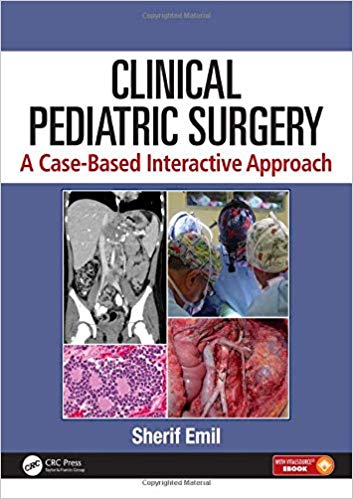Clinical Pediatric Surgery – a case-based interactive approach
Author- Sherif Emil
CRC Press 2020
Amazon Price £125
 Its not often that completely new general textbooks emerge mewling and puking into the world of paediatric surgery without any forebears or predecessors. The usual suspects such as Holcomb & Ashcraft is now in its 7th edition and priced at £232; Operative Pediatric Surgery (Spitz and Coran) is almost in its 8th edition; Pediatric Surgery (Coran and Adzick – 2 volumes) in the Expert Consult series is in its 7th Edition etc. and priced at £208. So it must have taken a lot of and inspiration, ambition and perspiration to try and compete in this big boys’ league particularly with a price which undercuts the aforementioned *.
Its not often that completely new general textbooks emerge mewling and puking into the world of paediatric surgery without any forebears or predecessors. The usual suspects such as Holcomb & Ashcraft is now in its 7th edition and priced at £232; Operative Pediatric Surgery (Spitz and Coran) is almost in its 8th edition; Pediatric Surgery (Coran and Adzick – 2 volumes) in the Expert Consult series is in its 7th Edition etc. and priced at £208. So it must have taken a lot of and inspiration, ambition and perspiration to try and compete in this big boys’ league particularly with a price which undercuts the aforementioned *.
There are seven sections from head and neck through trauma to miscellaneous, packed into 687 pages. It’s USP (well not that unique I suppose) is to start off with a scenario and run with it…. So the first chapter is on “Fetal Neck Masses” and begins “A prenatal ultrasound performed at 20 weeks of gestation in a healthy multiparous woman identifies a large left multiloculated cervical mass……” We then get a series of question and answers such as “What are the differential diagnoses …?” and further insight into what I presume are all real-life stories… This one turned out to be a teratoma that after being born by EXIT was excised later that day. Interwoven with the story are details of pathology, imaging etc. What was fascinating about the story was that this baby is now 17 years of age…and counting. There is a very nice photograph to prove it. Sometimes there is an element of just how current or up to date scenarios have to be. The discussion was certainly spot on though the last reference was from 2013.
It is limited by its format of course, if you deep dive into a subject you must miss or ignore some of the shallow pools along the way. Still, there is not a great deal missing from the
average surgeons’ repertoire. That is apart from the entire canon of paediatric urology. I suppose that’s not too surprising given the North American origin where urology is a completely separate entity only ever meeting somewhere in the region of the testis.
Sometimes, the story takes a surprising twist. The 2-month-old baby with a transilluminable scrotal swelling turns out to have an abdominoscrotal hydrocele with tubular remnants in the sac wall. The surgery, laparoscopic, is videoed and comes across well. The entire chapter takes up 8 pages but does take in other rare possibilities such as paratesticular rhabdomyosarcoma and hydroceles in adolescents. Both of these possibilities are fully illustrated as well.
The question and answer format does allow a very reasonable consideration of the pros and cons of a particular line of management and Dr Emil seems to balance opinion very well. Everyone has fairly fixed ideas on how to manage gastroschisis for instance. Early versus near-term delivery; pre-formed silos versus immediate fascial closure; in-born versus out-born delivery etc. Each one of these propositions are examined in turn and discussed and from this a distillation of experience is presented.
Of course, I looked quizzically at the hepatobiliary section but even if I don’t quite recognise the choledochal classification he uses, the management of an antenatally detected choledochal cyst was unarguable and sometimes it is impossible to explain why a four week old non-jaundiced infant has no discernible connection between cyst and duodenum. Similarly, the child born with biliary atresia who ends up requiring a left lateral segmentectomy for a symptomatic bile lake at 2 years of age is an uncommon but illustrative scenario.
We live in a digital age and surgical textbooks do need to address this, given over 300 years of print on paper. Video appears to be the new frontier, and sometimes it can be the Wild West out there. There are 25 in all, although some of the links didn’t work for me. With commentary by the author and using an initial PowerPoint presentation of the case these are quite effective. Of course, the content is dominantly video-assisted laparoscopic or thoracoscopic cases. No-one seems to video open cases anymore.
That this is essentially a single-author magnum opus is really quite amazing given the breadth of our subject. You have to applaud the sheer hard work that went into it. As he says, he is writer of this work, not the editor which is the norm nowadays. The only collaborators appear to be pathologists who, I guess, provide the picturesque histological background. The other obvious contributors are the Montreal Children’s Hospital and before that the University of California, Irvine where these cases emerged from and, of course, the lifetime’s dedication to record the best and most interesting. It is a fine read and a great resource and a testament to the intellect and knowledge of a great general paediatric surgeon.
A review by Prof. Mark Davenport
*all prices quoted are from Amazon.co.uk